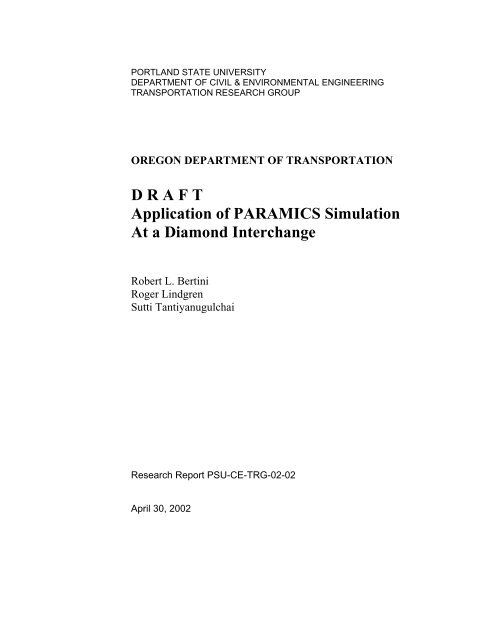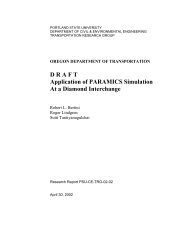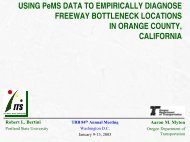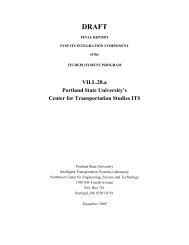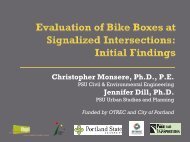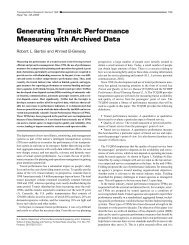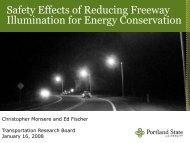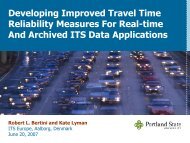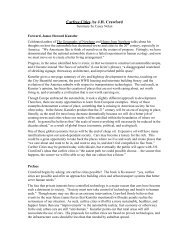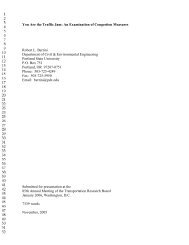Application of Paramics Simulation to a Diamond Interchange
Application of Paramics Simulation to a Diamond Interchange
Application of Paramics Simulation to a Diamond Interchange
Create successful ePaper yourself
Turn your PDF publications into a flip-book with our unique Google optimized e-Paper software.
PORTLAND STATE UNIVERSITY<br />
DEPARTMENT OF CIVIL & ENVIRONMENTAL ENGINEERING<br />
TRANSPORTATION RESEARCH GROUP<br />
OREGON DEPARTMENT OF TRANSPORTATION<br />
D R A F T<br />
<strong>Application</strong> <strong>of</strong> PARAMICS <strong>Simulation</strong><br />
At a <strong>Diamond</strong> <strong>Interchange</strong><br />
Robert L. Bertini<br />
Roger Lindgren<br />
Sutti Tantiyanugulchai<br />
Research Report PSU-CE-TRG-02-02<br />
April 30, 2002
<strong>Application</strong> <strong>of</strong> PARAMICS <strong>Simulation</strong> at a <strong>Diamond</strong> <strong>Interchange</strong> Page 1<br />
INTRODUCTION<br />
Computer processing advances have led <strong>to</strong> the increased use <strong>of</strong> traffic simulation models.<br />
Depending on the simulation objectives, models range from macroscopic models that use<br />
traffic descrip<strong>to</strong>rs such as flow, density and speed <strong>to</strong> microscopic models, which detail the<br />
movement <strong>of</strong> individual vehicles. (1) Macroscopic models are generally applied over large<br />
geographical areas and are more useful for transportation planning and corridor operations<br />
analysis rather than detailed traffic engineering in areas with complicated geometry and tight<br />
right-<strong>of</strong>-way restrictions. Because <strong>of</strong> the level <strong>of</strong> detail required in a microscopic model,<br />
applications tend <strong>to</strong>wards traffic operations over relatively small geographical areas.<br />
The Transportation Research Board’s Highway Capacity Manual (HCM) presents<br />
methodologies recommended for use in planning and operational analysis <strong>of</strong> an individual<br />
transportation network element such as a signalized intersection or a mainline section <strong>of</strong> a<br />
freeway. (1) The HCM equations and worksheets are based on limited statistical models that<br />
can be considered <strong>to</strong> be macroscopic. In part because the HCM models do not consider the<br />
behavior <strong>of</strong> individual vehicles, and due <strong>to</strong> the deterministic nature <strong>of</strong> HCM models, there is<br />
a growing recognition that s<strong>to</strong>chastic microscopic simulation models can be very useful in<br />
operational analyses on small <strong>to</strong> mid-sized transportation networks. HCM 2000 includes<br />
Chapter 31 titled “<strong>Simulation</strong> and Other Models,” (1) which summarizes a number <strong>of</strong><br />
strengths and shortcomings <strong>of</strong> simulation models, as shown in Table 1.<br />
Table 1 <strong>Simulation</strong> Models<br />
<strong>Simulation</strong> Modeling Strengths<br />
• Can vary demand over time and space<br />
• Can model unusual arrival and service patterns that do not follow more traditional mathematical<br />
distributions Can experiment <strong>of</strong>f-line without using on-line trial-and-error approach<br />
• Other analytical approaches may not be appropriate<br />
• Can experiment with new situations that do not exist <strong>to</strong>day<br />
• Can provide time and space sequence information as well as means and variances<br />
• Can study system in real time, compressed time, or expanded time<br />
• Can conduct potentially unsafe experiments without risk <strong>to</strong> system users<br />
• Can replicate base conditions for equitable comparison <strong>of</strong> improvement alternatives<br />
• Can study the effects <strong>of</strong> changes on the operation <strong>of</strong> a system<br />
• Can handle interacting queuing processes<br />
• Can transfer un-served queued traffic from one time period <strong>to</strong> the next<br />
<strong>Simulation</strong> Modeling Shortcomings<br />
• There may be easier ways <strong>to</strong> solve the problem<br />
• <strong>Simulation</strong> models may require verification, calibration, and validation, which, if overlooked, make such<br />
models useless or not dependable<br />
• Development <strong>of</strong> simulation models requires knowledge in a variety <strong>of</strong> disciplines, including traffic flow<br />
theory, computer programming and operation, probability, decision making, and statistical analysis<br />
• The simulation model may be difficult for analysts <strong>to</strong> use because <strong>of</strong> lack <strong>of</strong> documentation or need for<br />
unique computer facilities<br />
• Some users may apply simulation models and not understand what they represent<br />
• Some users may apply simulation models and not know or appreciate model limitations and assumptions<br />
• <strong>Simulation</strong> models require considerable input characteristics and data, which may be difficult or<br />
impossible <strong>to</strong> obtain<br />
• Results may vary slightly each time a model is run<br />
Portland State University Transportation Research Group 2002
<strong>Application</strong> <strong>of</strong> PARAMICS <strong>Simulation</strong> at a <strong>Diamond</strong> <strong>Interchange</strong> Page 2<br />
One strength <strong>of</strong> modern simulation models is that they are based on the random movements<br />
<strong>of</strong> each vehicle. This discrete modeling provides the opportunity <strong>to</strong> view the animated<br />
vehicles on a graphical representation <strong>of</strong> the network. In addition, microscopic traffic<br />
simulation models do not need <strong>to</strong> explicitly model such behavior as queueing, vehicle<br />
pla<strong>to</strong>ons, or shock waves. These situations occur in the simulation for the same reason they<br />
occur on the actual road networks, that is because they are natural consequences <strong>of</strong> the<br />
interaction <strong>of</strong> drivers, vehicles, road geometry and traffic control mechanisms. (2)<br />
The objective <strong>of</strong> this paper is <strong>to</strong> investigate the traffic engineering applications <strong>of</strong> Quads<strong>to</strong>ne<br />
PARAMICS, a popular microscopic traffic simulation model, at a particular site in Oregon.<br />
The Oregon Department <strong>of</strong> Transportation (ODOT) purchased the simulation s<strong>of</strong>tware in<br />
exchange for documentation <strong>of</strong> research experience gained by Portland State University’s<br />
Transportation Research Group.<br />
The study site consists <strong>of</strong> the area surrounding the diamond interchange <strong>of</strong> Interstate 5 (I-5)<br />
and Wilsonville Road, located in the city <strong>of</strong> Wilsonville, Oregon. Figure 1 shows the location<br />
<strong>of</strong> the study area. This interchange is characterized by high traffic volumes (80,000 average<br />
daily traffic—ADT—on I-5) and heavy peak hour traffic <strong>to</strong> and from the City <strong>of</strong> Wilsonville.<br />
The study described herein details the key features <strong>of</strong> the PARAMICS s<strong>of</strong>tware package,<br />
reports on actual modeling experience and evaluates its effectiveness in modeling a diamond<br />
interchange and several adjacent intersections.<br />
The next section <strong>of</strong> this report summarizes some <strong>of</strong> the recent literature related <strong>to</strong><br />
microscopic simulation <strong>of</strong> urban and freeway traffic. This is followed by a description <strong>of</strong> the<br />
PARAMICS s<strong>of</strong>tware package. Descriptions <strong>of</strong> the network and the data collection phases <strong>of</strong><br />
the project are then presented. Next, the model implementation stages, from network coding<br />
<strong>to</strong> model calibration and validation are discussed. Finally, the report ends with a review <strong>of</strong><br />
the major findings and a list <strong>of</strong> <strong>to</strong>pics requiring future research.<br />
BACKGROUND<br />
There are many microscopic traffic simulation models currently being used for research and<br />
practical purposes worldwide. The European Commission’s Transport Research and<br />
Technological Development program recently completed an assessment <strong>of</strong> current traffic<br />
microscopic simulation <strong>to</strong>ols. As shown in Table 2, the Commission’s research revealed the<br />
availability <strong>of</strong> 57 models, and categorized them by the traffic situation they are designed <strong>to</strong><br />
model, namely urban, freeway, urban and freeway, au<strong>to</strong>mated highway systems (AHS) or<br />
Other. (3)<br />
Portland State University Transportation Research Group 2002
<strong>Application</strong> <strong>of</strong> PARAMICS <strong>Simulation</strong> at a <strong>Diamond</strong> <strong>Interchange</strong> Page 3<br />
Table 2 Traffic Microscopic <strong>Simulation</strong> Tools<br />
Urban Freeway Urban & Freeway AHS Other<br />
ARTWORK AUTOBAHN AIMSUN2 PHAROS ANATOLL<br />
CASIM CARSIM CORSIM SHIVA MIMIC<br />
CASIMIR FOSIM FLEXSYT II SIMDAC PARKSIM<br />
DRACULA FREEVU INTEGRATION SMART-AHS TRARR<br />
HUTSIM FRESIM MELROSE SMARTPATH TRGMSM<br />
MICSTRAN INTRAS MICRO SPEACS VTI<br />
MISSION MIXIC MICROSIM<br />
MITRAM PELOPS MITSIM<br />
MULTSIM SIMCO PARAMICS<br />
NETSIM SISTM PLANSIM-T<br />
NEMIS WEAVSIM TRANSIMS<br />
PADSIM<br />
VISSIM<br />
SCATSIM<br />
SIGSIM<br />
SIMNET<br />
SITRA-B +<br />
SITRAS<br />
STEER<br />
STEP<br />
THOREAU<br />
Tiss-NET WIN<br />
TRAFFICQ<br />
The 12 microscopic traffic simulation models that were deemed capable <strong>of</strong> modeling both<br />
urban and freeway traffic were then evaluated on their ability <strong>to</strong> model intelligent<br />
transportation system (ITS) functions, as shown in Table 3. (3)<br />
Portland State University Transportation Research Group 2002
<strong>Application</strong> <strong>of</strong> PARAMICS <strong>Simulation</strong> at a <strong>Diamond</strong> <strong>Interchange</strong> Page 4<br />
Table 3 ITS Modeling Capabilities<br />
AIMSUN2<br />
CORSIM<br />
FLEXSYT-II<br />
INTEGRATION<br />
MELROSE<br />
MICROSIM<br />
MITSIM<br />
PARAMICS<br />
PLANSIM-T<br />
TRANSIM<br />
VISSIM<br />
ITS Functions modeled<br />
Coordinated traffic signals <br />
Adaptive traffic signals <br />
Priority <strong>to</strong> public transport <br />
Ramp metering <br />
Freeway flow control <br />
Incident management <br />
Zone access control <br />
Variable message signs <br />
Regional traffic information <br />
Static route guidance <br />
Dynamic route guidance <br />
Parking guidance<br />
<br />
Public transport information <br />
Au<strong>to</strong>matic debiting & <strong>to</strong>ll plazas <br />
Congestion pricing <br />
Adaptive cruise control<br />
<br />
Au<strong>to</strong>mated highway system <br />
Au<strong>to</strong>nomous vehicles<br />
<br />
Pedestrians and cyclists <br />
Probe vehicles <br />
Vehicle detec<strong>to</strong>rs <br />
Objects & phenomena modeled<br />
Weather conditions <br />
Searching for parking space <br />
Parked vehicles <br />
Elaborate engine model <br />
Commercial vehicles <br />
Bicycles / mo<strong>to</strong>r cycles<br />
<br />
Pedestrians <br />
Incidents <br />
Public transport vehicles <br />
Traffic calming measures <br />
Queue spill back <br />
Weaving <br />
Roundabouts <br />
Other properties<br />
Runs on a PC <br />
Runs on a UNIX machine <br />
Graphical Network Builder <br />
Graphical Presentation <strong>of</strong> Results <br />
Portland State University Transportation Research Group 2002
<strong>Application</strong> <strong>of</strong> PARAMICS <strong>Simulation</strong> at a <strong>Diamond</strong> <strong>Interchange</strong> Page 5<br />
Most models are constantly being updated; therefore the data shown in Tables 2 and 3 may<br />
not reflect the current state <strong>of</strong> a model’s functionality. As an example, the European<br />
Commission report states that PARAMICS runs only on UNIX computers, whereas the<br />
PARAMICS release used in this study (Version 3, Build 7) is capable <strong>of</strong> being run on a PC<br />
equipped with emula<strong>to</strong>r s<strong>of</strong>tware.<br />
What follows are brief summaries <strong>of</strong> recent literature related <strong>to</strong> microscopic traffic<br />
simulation <strong>to</strong>ols including PARAMICS and other commonly used models.<br />
Gardes, May, Dahlgren, and Skabardonis (4) assessed PARAMICS <strong>to</strong> serve as a <strong>to</strong>ol for<br />
evaluating freeway improvement strategies on Interstate 680 in the San Francisco Bay Area.<br />
The study emphasized the importance <strong>of</strong> calibrating the model and described the process <strong>of</strong><br />
developing a calibrated model in detail. The authors stated that results from a non-calibrated<br />
model should not be used. The authors recommended four key elements when calibrating the<br />
model. These include: network characteristics, traffic demand, overall simulation<br />
configuration, and driver behavior fac<strong>to</strong>rs.<br />
Lee, Yang, and Chandrasekar (5) described the importance <strong>of</strong> calibrating the PARAMICS<br />
model for local traffic conditions. The authors simulated a one-mile segment <strong>of</strong> Interstate 5<br />
in Orange County, California. Real-time loop detec<strong>to</strong>r data and two field data sets were<br />
collected and used in both calibration and validation processes. The authors stated that two<br />
key parameters used in the study were mean target headway and mean reaction time. The<br />
authors found that these calibrated parameter values indicated differences between California<br />
drivers’ behavior and the default values in PARAMICS.<br />
Stewart (6) described a study using PARAMICS <strong>to</strong> assess ramp meter control for eastbound<br />
traffic on Mo<strong>to</strong>rway 8 (M8) in Scotland. The author stated that the evaluation was performed<br />
with respect <strong>to</strong> the base model by comparing traffic flows, speeds, travel times, and behavior<br />
over strategic sections <strong>of</strong> the M8. The author found that the traffic simulation s<strong>of</strong>tware<br />
helped confirm that the introduction <strong>of</strong> ramp metering has improved the flow <strong>of</strong> traffic on the<br />
M8. However, the author cautioned that careful consideration <strong>of</strong> model boundaries is<br />
required since traffic flow on major roadways can be affected by distant flow interruptions.<br />
Moen et al. (7) evaluated three popular simulation packages: CORSIM, and TRANSYT-7F<br />
and VISSIM. Although their study did not include a diamond interchange, the modeling <strong>of</strong><br />
an area <strong>of</strong> down<strong>to</strong>wn Dallas, Texas described in the paper included closely spaced<br />
intersections with queue spillback and heavy traffic volumes. Overall, they found that<br />
CORSIM and VISSIM were suitable for predicting measures <strong>of</strong> effectiveness for various<br />
types <strong>of</strong> intersections, providing input for planning and operational decisions. The authors<br />
discussed a salient fact inherent in the attempt <strong>to</strong> compare simulated traffic delay measures<br />
with field data--they explained that the “<strong>to</strong>tal delay” computed by the simulation s<strong>of</strong>tware<br />
included all forms <strong>of</strong> delay, including delay caused by traffic flow fac<strong>to</strong>rs and geometric<br />
delay. This type <strong>of</strong> “<strong>to</strong>tal delay” data is very difficult <strong>to</strong> collect on actual street networks.<br />
The need for adequate model validation and calibration was also stressed.<br />
Portland State University Transportation Research Group 2002
<strong>Application</strong> <strong>of</strong> PARAMICS <strong>Simulation</strong> at a <strong>Diamond</strong> <strong>Interchange</strong> Page 6<br />
Lee and Messer (8) assessed three simulation models, two microscopic (CORSIM and<br />
SimTraffic) and one macroscopic (Synchro), for diamond interchange analysis. The<br />
researchers stated that either <strong>of</strong> the microscopic models could be used for analysis <strong>of</strong> actuated<br />
diamond interchanges including those with queue spillback. The researchers suggested that a<br />
large number <strong>of</strong> simulation runs be used <strong>to</strong> produce acceptable estimates <strong>of</strong> measures <strong>of</strong><br />
effectiveness.<br />
Bloomberg and Dale (9) compared two microscopic simulation models, CORSIM and<br />
VISSIM, for a simple intersection and a congested urban network, both in Seattle,<br />
Washing<strong>to</strong>n. They concluded that both models are useful for planning and operations level<br />
analyses. They made some comparisons <strong>of</strong> the microscopic simulation results <strong>to</strong> results <strong>of</strong><br />
HCM 2000 methodology and concluded that areas with queue spill-back may not be suited<br />
for the HCM’s macroscopic modeling techniques. The authors stated that many simulation<br />
runs are required for the proper use <strong>of</strong> the model output and they encouraged future research<br />
comparing simulated results <strong>to</strong> field data.<br />
Finally, Wang and Prevedouros (10) compared two microscopic simulation models,<br />
CORSIM and WARSim, on three small urban networks, including a diamond interchange in<br />
Honolulu, Hawaii. The study networks included video surveillance equipment and freeway<br />
loop detec<strong>to</strong>rs. The authors found that ability <strong>to</strong> calibrate such measures as density and speed<br />
with “real” traffic data aided in their confidence in the results <strong>of</strong> the simulation. The authors<br />
cautioned that default parameters embedded in simulation s<strong>of</strong>tware might not always produce<br />
reasonable results.<br />
There is a growing body <strong>of</strong> research related <strong>to</strong> microscopic traffic simulation as evidenced by<br />
the number <strong>of</strong> research paper presentations on this <strong>to</strong>pic at the most recent Transportation<br />
Research Board (TRB) Annual Meeting, in January, 2002. A common theme in much <strong>of</strong> the<br />
research is the need for proper model calibration and validation. The TRB Committee on<br />
Highway Capacity and Quality <strong>of</strong> Service is considering this issue and is planning a<br />
microscopic traffic model calibration and validation workshop at their 2002 mid-year<br />
meeting.<br />
SOFTWARE DESCRIPTION<br />
PARAMICS is a microscopic urban and freeway traffic simulation s<strong>of</strong>tware suite used <strong>to</strong><br />
model the movement and behavior <strong>of</strong> individual vehicles on road networks. 1 Quads<strong>to</strong>ne<br />
along with SIAS Ltd., a private engineering consultancy also based in Edinburgh, developed<br />
a Cray supercomputer version <strong>of</strong> PARAMICS at the University <strong>of</strong> Edinburgh’s Parallel<br />
Computing Center in the early 1990’s. (11)<br />
The PARAMICS name is an acronym derived from PARAllel computer MICropic<br />
<strong>Simulation</strong>. Since 1998 Quads<strong>to</strong>ne and SIAS have developed and marketed independent<br />
versions <strong>of</strong> PARAMICS. (11) Quads<strong>to</strong>ne distributes PARAMICS outside <strong>of</strong> the United<br />
Kingdom and Ireland, whereas SIAS handles marketing within the United Kingdom and<br />
1 PARAMICS is marketed in the United States by Quads<strong>to</strong>ne Ltd. <strong>of</strong> Edinburgh, Scotland, United Kingdom.<br />
Website http://www.paramics-online.com<br />
Portland State University Transportation Research Group 2002
<strong>Application</strong> <strong>of</strong> PARAMICS <strong>Simulation</strong> at a <strong>Diamond</strong> <strong>Interchange</strong> Page 7<br />
Ireland. This paper reports on the Quads<strong>to</strong>ne Ltd. PARAMICS Version 3 Build 7 that is<br />
currently being marketed in the United States.<br />
There are five modules within the PARAMICS s<strong>of</strong>tware package: Modeller, Processor,<br />
Analyser, Programmer, and Moni<strong>to</strong>r. A typical transportation engineering package consists<br />
<strong>of</strong> three <strong>of</strong> these modules – Modeller, Processor, and Analyser. (12) The Modeller module<br />
provides the ability <strong>to</strong> build, simulate, and visualize the road network using a graphical user<br />
interface. The Modeller module also allows for the creation <strong>of</strong> statistical output in the form<br />
<strong>of</strong> raw text files. The Processor module provides the same functionality as Modeller except<br />
that simulations occur without visualization, which increases the speed <strong>of</strong> the simulation.<br />
The Analyser module uses output data from each simulation run by Modeller <strong>to</strong> produce<br />
tabular and graphical results for <strong>of</strong>f-line analysis. (12)<br />
With PARAMICS one can model the movements <strong>of</strong> different types <strong>of</strong> vehicles. Vehicle type<br />
is defined by physical characteristics such as length, height, width, weight, and maximum<br />
speed. In addition <strong>to</strong> cars and trucks, one can model public transportation vehicles such as<br />
buses, light rail trains, and heavy rail trains. Pedestrian interaction with the road network can<br />
be modeled through the provision <strong>of</strong> pedestrian phases at signal-controlled intersections.<br />
Bicycle traffic can be modeled within in PARAMICS only where the network provides<br />
dedicated bicycle lanes. (13)<br />
The PARAMICS Modeller is a s<strong>to</strong>chastic, microscopic, time step, and behavior-based<br />
simulation model. Using one set <strong>of</strong> input data, s<strong>to</strong>chastic models result in unique solutions<br />
each time they are run as opposed <strong>to</strong> deterministic models that produce identical results each<br />
time. With s<strong>to</strong>chastic modeling, the idea is that the model can be run many times and mean<br />
values <strong>of</strong> output can be calculated. The delay equations employed in the HCM methodology<br />
for analysis <strong>of</strong> a signalized intersection are an example <strong>of</strong> a deterministic model. Time step<br />
models simulate dynamic traffic conditions by establishing the location and attributes <strong>of</strong> each<br />
vehicle at a given point in time, then “skipping” forward a pre-determined “time step,” and<br />
then reestablishing each vehicle’s location and attributes. The motion <strong>of</strong> vehicles in<br />
PARAMICS, like in other microscopic traffic models, is actually composed <strong>of</strong> a series <strong>of</strong><br />
discrete steps, which, when strung <strong>to</strong>gether, result in the perception <strong>of</strong> motion. When viewed<br />
on a computer screen, the “picture” is refreshed at each time step with the vehicle’s new<br />
position on the network. The result is an animation that displays vehicles moving throughout<br />
the network. Figure 2 shows simulated vehicles on the study network. Behavior-based<br />
traffic models employ fac<strong>to</strong>rs in order <strong>to</strong> mimic the behavior <strong>of</strong> individual drivers. Neither<br />
the current literature nor the PARAMICS s<strong>of</strong>tware documentation contains specific details<br />
on the theory behind the driver behavior modeling inherent in PARAMICS. However,<br />
reference is made <strong>to</strong> research conducted at the British Transportation Research Labora<strong>to</strong>ry<br />
(TRL) that concludes that driver behavior can be described by two parameters: aggression<br />
and awareness. PARAMICS randomly assigns values <strong>of</strong> aggression and awareness <strong>to</strong> the<br />
driver <strong>of</strong> each vehicle on a scale <strong>of</strong> 1-8. These parameters have an effect on such quantities as<br />
target headway, <strong>to</strong>p speed, propensity <strong>to</strong> change lane and gap acceptance <strong>of</strong> the individuals.<br />
One can alter the type <strong>of</strong> statistical distribution (i.e., Normal, Poisson) <strong>of</strong> the aggression and<br />
awareness parameters <strong>to</strong> reflect regional variations in driver behavior. With the assigned<br />
aggression and awareness parameters, three interacting models then control the movement <strong>of</strong><br />
Portland State University Transportation Research Group 2002
<strong>Application</strong> <strong>of</strong> PARAMICS <strong>Simulation</strong> at a <strong>Diamond</strong> <strong>Interchange</strong> Page 8<br />
each vehicle: a vehicle following model, a gap acceptance model, and a lane changing model.<br />
(12)<br />
The accuracy achieved in a microscopic traffic simulation model depends on the accuracy <strong>of</strong><br />
the coding <strong>of</strong> network features. Because vehicles react individually <strong>to</strong> geometric constraints<br />
such as narrow lane widths and small turning radii, it is vital that the modeled network<br />
represent actual conditions. Network coding in PARAMICS is based on “nodes” and<br />
“links,” where each link is coded as a connec<strong>to</strong>r between two nodes. Network creation is<br />
accomplished within a graphical user interface that allows the user <strong>to</strong> build the network with<br />
computer drafting commands either in freehand drawing <strong>of</strong> links or by drawing on <strong>to</strong>p <strong>of</strong> a<br />
template road geometry file such as an aerial pho<strong>to</strong>graph or a CAD drawing. Figure 2 shows<br />
the PARAMICS network constructed for the I-5 and Wilsonville Road interchange area on a<br />
background aerial pho<strong>to</strong>graph.<br />
Details associated with each link specify the characteristics <strong>of</strong> the roadway such as number <strong>of</strong><br />
lanes, lane width, types <strong>of</strong> roadway, and design speeds. The PARAMICS driver behavior<br />
model interacts with the network geometry, causing changes in vehicle speed and position<br />
depending on:<br />
• Position <strong>of</strong> s<strong>to</strong>p and curb lines<br />
• Intersection signal times<br />
• Intersection coding (fixed time and actuated)<br />
• Location <strong>of</strong> bus s<strong>to</strong>ps<br />
• Location <strong>of</strong> pedestrian crossings<br />
• Lane control and access restrictions<br />
• Areas where on-street parking affect the performance <strong>of</strong> vehicles.<br />
An origin-destination matrix defines travel demand in PARAMICS. However, traffic<br />
engineers typically collect data in the form <strong>of</strong> intersection turning movement diagrams. A<br />
conversion from turning movements <strong>to</strong> an origin-destination matrix is required. This step<br />
will be explained further in the Model Implementation section <strong>of</strong> this report.<br />
Traffic assignment in PARAMICS applies <strong>to</strong> all vehicle types except fixed route vehicles,<br />
such as buses and trains. The travel cost for each vehicle <strong>to</strong> reach its destination is calculated<br />
at each time step according <strong>to</strong> the following generalized cost function.<br />
Cost = a*T + b*D + c*P<br />
Where:<br />
a = Time coefficient in minutes per minute (default 1.0)<br />
b = Distance coefficient in minutes per kilometer (default 0.0)<br />
c = Toll coefficient in minutes per monetary cost (default 0.0)<br />
T = Free-flow travel time in minutes<br />
D = Length <strong>of</strong> the link in kilometers<br />
P = Price <strong>of</strong> the <strong>to</strong>ll in monetary cost units<br />
Portland State University Transportation Research Group 2002
<strong>Application</strong> <strong>of</strong> PARAMICS <strong>Simulation</strong> at a <strong>Diamond</strong> <strong>Interchange</strong> Page 9<br />
Coefficients a, b and c can be changed <strong>to</strong> reflect conditions on the modeled network.<br />
The following assignment techniques can be implemented in PARAMICS:<br />
• All-or-nothing assignment method – assumes that all drivers are traveling with the<br />
same knowledge base for route choice and there is no congestion effect. Link costs do<br />
not depend on the flow levels.<br />
• S<strong>to</strong>chastic assignment method – emphasizes the variability in drivers’ perceptions <strong>of</strong><br />
costs and the composite measure that they try <strong>to</strong> minimize (distance, travel time,<br />
generalized cost).<br />
• Dynamic feedback assignment – assumes that the drivers who are familiar with the<br />
road network will reroute if information on current traffic conditions is provided <strong>to</strong><br />
them.<br />
On-screen observation and evaluation <strong>of</strong> the animation then allows the user <strong>to</strong> observe traffic<br />
operations and make notes <strong>of</strong> such things as inefficient signal timings and <strong>of</strong>fsets, queue<br />
spillback, insufficient s<strong>to</strong>rage and weaving problems. A wide variety <strong>of</strong> data including route<br />
travel time, delay, queue length, and link volumes can be collected during each simulation<br />
run and s<strong>to</strong>red in data files for <strong>of</strong>f-line analysis.<br />
The value <strong>of</strong> the on-screen visualization cannot be overstated; at the model development<br />
stage, the animations reveal problems with the network coding immediately. For example, if<br />
vehicles are not s<strong>to</strong>pping at a red light or are traveling <strong>to</strong>o quickly around a corner, it is<br />
visible and can be easily corrected. Once the model is complete and being used for analysis,<br />
the on-screen visualization allows one <strong>to</strong> see complex traffic interactions such as queue<br />
spillbacks and blocked intersections that are extremely difficult <strong>to</strong> predict with equationbased<br />
deterministic models.<br />
Microscopic traffic simulation can also be used <strong>to</strong> test future geometric layouts and traffic<br />
control strategies. Left turn pockets can be lengthened, new lanes can be added <strong>to</strong> a link and<br />
the change in delay and travel time can be estimated. Fixed time signals can be modeled as<br />
actuated. Future traffic volumes and traffic compositions can also be modeled.<br />
PROJECT APPLICATION<br />
Project Location<br />
The model network for this project is the area surrounding the intersection <strong>of</strong> I-5 and<br />
Wilsonville Road located in the City <strong>of</strong> Wilsonville, Oregon as shown in Figures 1 and 2.<br />
The network includes the diamond interchange at I-5 and Wilsonville Road as well as the<br />
Wilsonville Road intersections with Boones Ferry Road, Parkway Avenue and Town Center<br />
Loop West.<br />
Portland State University Transportation Research Group 2002
<strong>Application</strong> <strong>of</strong> PARAMICS <strong>Simulation</strong> at a <strong>Diamond</strong> <strong>Interchange</strong> Page 10<br />
Data Collection<br />
Afternoon peak hour intersection turning movement counts for a number <strong>of</strong> the intersections<br />
in the study area intersections were acquired by DKS Associates, an engineering consulting<br />
firm, in April 1999. Figure 3 show the DKS turning movement counts. Aerial pho<strong>to</strong>graphs<br />
obtained from GlobeXplorer Inc. and as-built construction CAD drawings provided by the<br />
City <strong>of</strong> Wilsonville were used <strong>to</strong> establish network geometry. Ground level pho<strong>to</strong>graphs<br />
were taken <strong>of</strong> the approaches <strong>of</strong> each intersection <strong>to</strong> provide network detail that was not<br />
apparent from the aerial pho<strong>to</strong>graphs.<br />
The four signalized intersections in the study area are controlled by fully actuated signals.<br />
However, during the congested afternoon peak period, the signals appeared <strong>to</strong> operate with<br />
phase timings that approached fixed-time condition (as is <strong>of</strong>ten the case at diamond<br />
interchanges). Fixed-timed signal phase lengths for the computer model were based on the<br />
average <strong>of</strong> ten observed p.m. peak period cycles obtained on December 13, 2001.<br />
SOFTWARE INSTALLATION<br />
For PARAMICS operation on a PC, Quads<strong>to</strong>ne recommends a computer with a Pentium 266<br />
or better processor, 64MB Memory, and 100MB hard disk space. A graphics card supporting<br />
OpenGL, minimum 1280x1024 resolution, and 32Bit color depth is suggested. The<br />
PARAMICS s<strong>of</strong>tware is designed for UNIX operating systems. In order <strong>to</strong> execute<br />
PARAMICS under a Windows operating system on a PC, a separate piece <strong>of</strong> emula<strong>to</strong>r<br />
s<strong>of</strong>tware known generically as “X-windows s<strong>of</strong>tware” is required. PARAMICS recommends<br />
the use <strong>of</strong> Exceed and Exceed 3D X-windows s<strong>of</strong>tware produced by Hummingbird Ltd. <strong>of</strong><br />
North York, Ontario, Canada. Exceed s<strong>of</strong>tware was used in the research detailed in this<br />
report. The X-Windows s<strong>of</strong>tware must be installed on the computer before PARAMICS is<br />
installed. (14)<br />
In order <strong>to</strong> operate PARAMICS with full functionality, a current s<strong>of</strong>tware license file issued<br />
by Quads<strong>to</strong>ne and a hasp key (connected <strong>to</strong> the computer’s parallel port) are required.<br />
PARAMICS Modeller can however, be executed without license or hasp key in a Viewer<br />
Mode as described in Figure 4. The Viewer Mode allows models <strong>to</strong> be viewed but not<br />
modified.<br />
MODEL IMPLEMENTATION<br />
The typical implementation steps involved in a microscopic traffic simulation model are as<br />
follows:<br />
• Road network coding<br />
• Traffic demand matrix input<br />
• Traffic assignment technique selection<br />
• <strong>Simulation</strong> run execution (normally with visualization)<br />
• Base model calibration (by comparing model results <strong>to</strong> observed data)<br />
• Model validation the model against independent data<br />
Portland State University Transportation Research Group 2002
<strong>Application</strong> <strong>of</strong> PARAMICS <strong>Simulation</strong> at a <strong>Diamond</strong> <strong>Interchange</strong> Page 11<br />
• Results analysis (in real time by observing visualization and <strong>of</strong>f-line by analyzing<br />
model results files)<br />
Road Network<br />
PARAMICS networks are coded using a graphical user interface. PARAMICS uses nodes<br />
and links so for this study, a network skele<strong>to</strong>n was created by placing links directly on a<br />
bitmap image <strong>of</strong> an aerial pho<strong>to</strong>graph <strong>of</strong> the area (Figure 2). Detailed information on each<br />
intersection node was then input based on CAD drawings, ground level pho<strong>to</strong>graphs, and<br />
field measurements.<br />
Traffic Demand Matrix<br />
In PARAMICS, an origin-destination matrix defines traffic demand. The network<br />
considered for the present study was modeled with nine zones, with a zone located at the end<br />
<strong>of</strong> each link that allows vehicles <strong>to</strong> either enter or leave the modeled area as shown in Figure<br />
5. It is rare that traffic engineers have a balanced origin-destination matrix available <strong>to</strong> them<br />
for traffic operations analyses. It is more likely, as in the case <strong>of</strong> this study, that intersection<br />
turning movement counts are available, or are easy <strong>to</strong> collect. For this study, a simple fourstep<br />
process was employed <strong>to</strong> create a balanced origin-destination matrix from the available<br />
intersection turning movement counts.<br />
First, because the turning movement counts were obtained at different times, there was the<br />
potential for unbalanced traffic volumes <strong>to</strong> exist for each link. For example, referring <strong>to</strong><br />
Figure 6, the hourly counts at intersection 2 show 1327 vehicles traveling on the eastbound<br />
Wilsonville Road link, whereas the counts at intersection 3 show 1323 vehicles for the same<br />
link. This link volume was equalized by adding 4 vehicles <strong>to</strong> the eastbound approach <strong>of</strong><br />
intersection 3 and allocating these 4 vehicles on a proportional basis <strong>to</strong> the movements<br />
allowed at this approach as shown in Figure 7. This process was repeated for each link in the<br />
network <strong>to</strong> create a set <strong>of</strong> adjusted turning movement diagrams as shown in Figure 8.<br />
Next, an unbalanced origin-destination matrix was created by distributing each zone trip<br />
production <strong>to</strong>tal proportionally through each network intersection until an attraction zone was<br />
reached. For example, referring <strong>to</strong> Figure 9, Zone 9 produces 725 vehicles in the design<br />
hour; 4.6% or 33 <strong>of</strong> those 725 vehicles are destined for Zone 6, 4.1% or 30 vehicles are<br />
destined for Zone 7, and 12.4% (91.3% x 57.8% x 47.5% x 91.8% x 97% x 55.7%) or 90<br />
vehicles are destined for Zone 3. This process was repeated for each origin-destination<br />
pairing <strong>to</strong> create the unbalanced origin-destination matrix shown in Table 4.<br />
The next step was an adjustment <strong>of</strong> each actual zonal attraction <strong>to</strong>tal so that the <strong>to</strong>tal<br />
attractions were equal <strong>to</strong> the <strong>to</strong>tal productions. As summarized in Table 4, the original<br />
turning movement counts (TMC) show 10,783 vehicles attracted <strong>to</strong> the ten network zones.<br />
This is 87 more vehicles than the TMC <strong>to</strong>tal <strong>of</strong> 10,696 vehicles produced by these same ten<br />
zones. Each zonal attraction <strong>to</strong>tal was therefore adjusted by adding a number <strong>of</strong> vehicles in<br />
proportion <strong>to</strong> that zone’s contribution <strong>to</strong> the <strong>to</strong>tal. For example, it can be seen in Figure 3<br />
that Zone 8 attracted 586 (502+38+46) vehicles; 586 vehicles represent 5.5% <strong>of</strong> the <strong>to</strong>tal,<br />
Portland State University Transportation Research Group 2002
<strong>Application</strong> <strong>of</strong> PARAMICS <strong>Simulation</strong> at a <strong>Diamond</strong> <strong>Interchange</strong> Page 12<br />
therefore 5.5% <strong>of</strong> the 87-vehicle deficit (5 vehicles) was added <strong>to</strong> the Zone 8 <strong>to</strong>tal making the<br />
<strong>to</strong>tal 591 vehicles as shown in Table 5. This process was repeated for each zonal attraction<br />
<strong>to</strong>tal creating a balance among the overall zonal production and attraction <strong>to</strong>tals as shown in<br />
Table 5.<br />
Finally, a balanced origin-destination matrix was created by an iterative proportional fitting<br />
(IPF) process. The IPF process adjusted the individual origin-destination cell values <strong>of</strong> the<br />
unbalanced matrix (Table 4) through a series <strong>of</strong> iterations until the overall zonal production<br />
and attraction <strong>to</strong>tals matched the adjusted actual turning movement count <strong>to</strong>tals determined in<br />
the previous step. For the first IPF iteration, each cell value was multiplied by an attractionbased<br />
balance fac<strong>to</strong>r that was created by dividing the unbalanced zonal attraction <strong>to</strong>tal by the<br />
actual zonal attraction <strong>to</strong>tal for that zone. For example, Zone 1 attracted 3994 vehicles in the<br />
unbalanced matrix, while the actual zonal attraction should be 4095. Therefore a balance<br />
fac<strong>to</strong>r <strong>of</strong> 4095/3994 or 1.025 was established. This process was repeated for each zone and<br />
new cell values were computed as the product <strong>of</strong> the balance fac<strong>to</strong>r and the original cell<br />
value. The matrix created by this initial iteration has, by design, perfectly matching zonal<br />
attraction <strong>to</strong>tals but will leave the zonal production <strong>to</strong>tals out <strong>of</strong> balance. The next iteration<br />
was therefore applied in a similar manner <strong>to</strong> zonal production <strong>to</strong>tals. The iterative steps that<br />
followed alternated balancing between attraction and production <strong>to</strong>tals until a maximum<br />
allowable difference was achieved. For this project, the maximum error was set at 2.0<br />
vehicles and thirty iterations were required <strong>to</strong> meet this goal. The balanced origin-destination<br />
matrix for PARAMICS modeling is shown in Table 4.<br />
Traffic Assignment Technique Selection<br />
The study area was a small network with only one route possible between each origin and<br />
destination, therefore the all-or-nothing technique was chosen.<br />
<strong>Simulation</strong> Run Execution<br />
Due <strong>to</strong> the s<strong>to</strong>chastic nature <strong>of</strong> simulation models, a relatively large number <strong>of</strong> runs must be<br />
conducted in order <strong>to</strong> estimate key measures <strong>of</strong> effectiveness with reasonable accuracy. Each<br />
PARAMICS model run with identical operation conditions but with different “random seed”<br />
numbers will produce different results.<br />
The “random seed” is required since driver behavior parameters are assigned <strong>to</strong> each<br />
simulated vehicle according <strong>to</strong> a predefined distribution. For example simulation run 1 with<br />
a random seed <strong>of</strong> 17 might assign <strong>to</strong> vehicle 1 an aggression parameter <strong>of</strong> 6, vehicle 2 with<br />
an aggression parameter <strong>of</strong> 4, etc. Each time a model run is initiated with a random seed <strong>of</strong><br />
17, each vehicle will be assigned the same behavior parameters as in the previous random<br />
seed 17 run and therefore all traffic operations and measures <strong>of</strong> effectiveness (MOEs) such as<br />
delay will be the same. Using the same random seed essentially reduces the model <strong>to</strong> a<br />
deterministic level. For better results, a random number table should be used when assigning<br />
random seed numbers.<br />
It is prudent <strong>to</strong> execute an initial number <strong>of</strong> simulation runs, and use the statistical estima<strong>to</strong>rs<br />
from this trial <strong>to</strong> compute the number <strong>of</strong> simulation runs required <strong>to</strong> meet a stated objective<br />
Portland State University Transportation Research Group 2002
<strong>Application</strong> <strong>of</strong> PARAMICS <strong>Simulation</strong> at a <strong>Diamond</strong> <strong>Interchange</strong> Page 13<br />
(i.e., 90% or 95% level <strong>of</strong> confidence), according <strong>to</strong> commonly accepted statistical<br />
principles.<br />
The following equation (15) can be used <strong>to</strong> compute the required number <strong>of</strong> simulation runs,<br />
where:<br />
s 2<br />
n r<br />
≥<br />
s<br />
2<br />
z<br />
ε<br />
2<br />
α / 2<br />
2<br />
= variance (based on trial runs)<br />
z α/2 = threshold value for a 100(1-α) percent confidence interval<br />
n r = number <strong>of</strong> runs required<br />
ε = maximum error <strong>of</strong> the estimate<br />
The following interchange delay data I-5 <strong>Interchange</strong> with Wilsonville Road was determined<br />
from 15 PARAMICS simulation runs:<br />
Mean delay = 31.44 s<br />
s 2 <strong>of</strong> this data = 3.10 s 2<br />
s = 1.76 s<br />
α = 0.05 (corresponds with 95% confidence)<br />
α/2 = 0.025 (corresponds with 95% confidence)<br />
Z = 1.96 from statistical table (15)<br />
ε =1.0 s (based on reasonable error <strong>of</strong> delay estimate)<br />
2 2<br />
s z α<br />
2<br />
2<br />
(3.10)1.96<br />
n r<br />
≥ =<br />
≈ 12 runs<br />
2<br />
2<br />
ε 1.0<br />
As shown, for this study it was determined that 12 simulation runs were required in order <strong>to</strong><br />
establish an estimate for interchange delay with a 1.0 second maximum allowable error and a<br />
95% level <strong>of</strong> confidence.<br />
Base Model Calibration<br />
Before calibration can be performed, it must be apparent <strong>to</strong> the modeler that the network is<br />
verified so that that all possible movements at the real intersection are being properly<br />
modeled. Is easy <strong>to</strong> verify a PARAMICS network given the visualization that is inherent in<br />
the modeling process. This verification step is followed by a more formal base model<br />
calibration.<br />
The first step in calibrating a microscopic model is <strong>to</strong> observe the visualization and determine<br />
whether the traffic is moving through the network in a realistic manner. These observations<br />
can be compared <strong>to</strong> on-site observation <strong>of</strong> the traffic or by viewing traffic camera video<br />
Portland State University Transportation Research Group 2002
<strong>Application</strong> <strong>of</strong> PARAMICS <strong>Simulation</strong> at a <strong>Diamond</strong> <strong>Interchange</strong> Page 14<br />
output. During the simulation, statistics such as <strong>to</strong>tal travel time, <strong>to</strong>tal distance traveled and<br />
average vehicle speeds can be written <strong>to</strong> data files and used <strong>to</strong> compare differences between<br />
each model run and also compared <strong>to</strong> field data.<br />
In general, the need for further calibration can be identified by comparisons between<br />
modeled and observed data that could include the following:<br />
• Traffic flows<br />
• Queue lengths (maximum and average) and s<strong>to</strong>p time<br />
• Delays (network wide and at individual junctions)<br />
• Traffic speeds<br />
• Traffic density<br />
• Travel times<br />
Quads<strong>to</strong>ne suggests that most networks can be sufficiently calibrated by adjusting the<br />
physical network <strong>to</strong> more closely resemble the actual streets and/or by making coding<br />
changes <strong>to</strong> links and nodes <strong>to</strong> permit vehicle movements like those observed on the actual<br />
street. (16) Commonly used calibration parameters include:<br />
• Including actual link gradients (all links are flat by default)<br />
• Inserting link instructions that either force merging or force “stay in lane” behavior<br />
that will override the PARAMICS lane changing model<br />
In the case <strong>of</strong> the Wilsonville Road study, a preliminary calibration was achieved by network<br />
alterations suggested by a comparison between modeled and observed travel times.<br />
Model Validation<br />
Validation is the process <strong>of</strong> determining whether the driver behavior models inherent in the<br />
s<strong>of</strong>tware package are producing results that match with observed driver behavior. In this<br />
study, model validation was accomplished with an empirical comparison <strong>of</strong> the results <strong>of</strong><br />
several simulation runs with behavior observed during several site visits and also using a<br />
comparison with generally expected driver behavior. Again, the on-line viewing <strong>of</strong> the<br />
simulation runs greatly enhanced the modeler’s ability <strong>to</strong> identify unexpected driver<br />
behavior.<br />
The overall behavior <strong>of</strong> the PARAMICS model can be changed considerably by modifying<br />
the “mean target headway” and “mean reaction time” or by altering the driver behavior<br />
“aggression” and “awareness” distributions. (4, 16) Alteration <strong>of</strong> these values based on<br />
model run comparisons <strong>to</strong> data sets collected on the actual network constitute a more<br />
rigorous model validation procedure.<br />
Quads<strong>to</strong>ne has set the PARAMICS mean headway and reaction times <strong>to</strong> default values <strong>of</strong> 1.0<br />
seconds based on speed and headway data extracted from loop detec<strong>to</strong>rs on freeways in the<br />
United Kingdom (16). For a small, suburban network like the Wilsonville road study area,<br />
these default values should suffice, since, with the exception <strong>of</strong> the ramp entrances <strong>to</strong> I-5,<br />
Portland State University Transportation Research Group 2002
<strong>Application</strong> <strong>of</strong> PARAMICS <strong>Simulation</strong> at a <strong>Diamond</strong> <strong>Interchange</strong> Page 15<br />
there is little high-speed, high-volume traffic. Current research (4) suggests that for freeway<br />
analysis, there is a real need <strong>to</strong> validate the model by calibrating the headway and reaction<br />
times <strong>to</strong> match local conditions.<br />
Analysis <strong>of</strong> Results<br />
Travel Time<br />
Travel time data were collected during ten PARAMICS simulation runs on three routes as<br />
shown in Figure 10. A small data set comprised <strong>of</strong> five actual timed trips for each route was<br />
acquired at the site on December 13, 2001. PARAMICS simulation results appear <strong>to</strong> be<br />
reasonable predic<strong>to</strong>rs <strong>of</strong> travel time for Routes 1 and 3. The discrepancy in the simulated<br />
versus actual travel times on Route 2 may have resulted from simulating the intersections<br />
with fixed time coordinated signals while the actuated signals at times did not appear <strong>to</strong> be<br />
coordinated <strong>to</strong> provide progressive flow. The nature <strong>of</strong> the actuation logic may lead <strong>to</strong> a lack<br />
<strong>of</strong> coordination among the series <strong>of</strong> signals traversed in Route 2.<br />
Average Vehicle Delay<br />
Average vehicle delay data were collected during ten PARAMICS simulation runs for<br />
selected approaches <strong>of</strong> the two I-5 ramp intersections with Wilsonville Road. For each<br />
simulated intersection movement, delay was computed using procedures outlined in the<br />
HCM. Chapter 26 (<strong>Interchange</strong> Ramp Terminals) <strong>of</strong> the HCM 2000 recommends the<br />
evaluation <strong>of</strong> delays at diamond interchanges using procedures from Chapter 16 (Signalized<br />
Intersections). (1) These procedures form the basis for the “Signals” module <strong>of</strong> the Highway<br />
Capacity S<strong>of</strong>tware (HCS) 2000. Examples <strong>of</strong> lane group delays predicted by HCS and<br />
PARAMICS are shown in Figure 11.<br />
The HCM lane group incremental delay computation includes an Upstream Filtering or<br />
Metering Adjustment Fac<strong>to</strong>r (I) <strong>to</strong> account for the effect <strong>of</strong> metered arrivals from an<br />
upstream intersection. The HCM methodology recommends that a fac<strong>to</strong>r <strong>of</strong> I = 1.0 be used<br />
for isolated intersections where the arrival pattern would follow a random distribution. For<br />
the closely spaced intersections such as those in the study network, the HCM methodology<br />
suggests that the I fac<strong>to</strong>r be computed using the following equation:<br />
I<br />
=<br />
2.68<br />
1.0<br />
− 0.91X<br />
u<br />
X u is approximately the volume <strong>to</strong> capacity (V/C) ratio <strong>of</strong> the upstream through movement.<br />
While it appears logical that the delay <strong>of</strong> a lane group will be lower when the arrival rates are<br />
non-uniform and the signals are coordinated <strong>to</strong> take advantage <strong>of</strong> this type <strong>of</strong> arrival pattern,<br />
the HCM delay calculation method contains empirical fac<strong>to</strong>rs which makes the comparison<br />
<strong>of</strong> a single fac<strong>to</strong>r such as the Upstream Filtering or Metering Adjustment Fac<strong>to</strong>r <strong>to</strong> a<br />
fundamental principle <strong>of</strong> traffic flow very difficult.<br />
Incremental delay is defined in the HCM 2000 as “delay due <strong>to</strong> non-uniform arrivals and<br />
temporary cycle failures … as well as delay caused by sustained periods <strong>of</strong> over saturation.”<br />
After viewing ten hours <strong>of</strong> PARAMICS simulations, there were virtually no instances <strong>of</strong><br />
oversaturation or cycle failures observed using existing volumes.<br />
Portland State University Transportation Research Group 2002
<strong>Application</strong> <strong>of</strong> PARAMICS <strong>Simulation</strong> at a <strong>Diamond</strong> <strong>Interchange</strong> Page 16<br />
Comparisons <strong>of</strong> HCS and PARAMICS average vehicle delay for all eight movements reveal<br />
relatively small differences. While this in an interesting observation, it does not necessarily<br />
prove the usefulness <strong>of</strong> either method. The HCS methodology for delay calculation is simply<br />
a “model” <strong>of</strong> traffic flow that can be described as deterministic and macroscopic.<br />
Traffic Demand Variations<br />
The hourly traffic volumes used in this study were based on p.m. peak hour vehicle volume<br />
data acquired by DKS Associates in May 1999 as shown in Figure 3. These data came in the<br />
form <strong>of</strong> intersection turning movement counts for the six intersections in the network. To<br />
explore how the network would respond <strong>to</strong> changes in traffic demand, the network was<br />
loaded with several hypothetical levels <strong>of</strong> traffic volumes (referred <strong>to</strong> here as Low, Medium,<br />
High, and Very High). These traffic levels corresponded <strong>to</strong> 0.5, 0.75, 1.0 and 1.25 times the<br />
May, 1999 p.m. peak hour volumes respectively.<br />
Figure 12 shows the simulated interchange delay at these four traffic levels. <strong>Interchange</strong><br />
delay was again computed by weighting the delay <strong>of</strong> each <strong>of</strong> the ramp intersection<br />
movements by that movement’s average proportion <strong>of</strong> <strong>to</strong>tal vehicles served. Average delays<br />
increased with increasing traffic, which is consistent with expectations. Of particular interest<br />
was the observation <strong>of</strong> the animation during the Very High traffic load. The animation<br />
showed that there were several instances when the queues <strong>of</strong> both eastbound and westbound<br />
Wilsonville Road traffic spilled back, limiting movement at the adjacent ramp intersection.<br />
Any methodology that aims <strong>to</strong> accurately predict interchange delays at times heavy traffic<br />
flow must recognize the impact <strong>of</strong> queue spill-back.<br />
Modeling Geometric Changes<br />
One <strong>of</strong> the strengths <strong>of</strong> simulation models is the ability <strong>to</strong> experiment with new situations<br />
that do not exist <strong>to</strong>day. The traffic demand variation analysis discussed in the previous<br />
section is one example <strong>of</strong> such future situations. Another example is modeling hypothetical<br />
changes in network geometry such as the addition <strong>of</strong> a new lane, turn bay, or other physical<br />
change <strong>to</strong> the network.<br />
In the traffic demand variation, it was observed that at Very High traffic levels (1.25 times<br />
the 1999 levels) there was a substantial delay for the I-5 Northbound ramp left turning<br />
movement <strong>to</strong> westbound Wilsonville Road. With a single left turn lane, the average vehicle<br />
delay was 74.9 seconds. When a second left turn lane was added, the delay <strong>of</strong> this same<br />
movement was reduced <strong>to</strong> 34.4 seconds. While it is clear in this case that a lane addition<br />
would decrease delay, the simulation model allows for detailed analyses <strong>of</strong> such situations<br />
with a minimum <strong>of</strong> effort. With PARAMICS, once the initial network is coded and validated,<br />
it is a simple process <strong>to</strong> make changes and <strong>to</strong> study the impact <strong>of</strong> the changes, both visually<br />
on-line and by an <strong>of</strong>f-line analysis <strong>of</strong> the collected data.<br />
CONCLUSIONS<br />
This report has documented experience with the use <strong>of</strong> a computerized microscopic<br />
s<strong>to</strong>chastic traffic simulation <strong>to</strong>ol (Quads<strong>to</strong>ne PARAMICS) as means <strong>of</strong> evaluating a small<br />
Portland State University Transportation Research Group 2002
<strong>Application</strong> <strong>of</strong> PARAMICS <strong>Simulation</strong> at a <strong>Diamond</strong> <strong>Interchange</strong> Page 17<br />
urban traffic network including a diamond interchange on an interstate highway. From the<br />
analysis <strong>of</strong> results, the following conclusions were drawn.<br />
Simulated interchange delay results from the PARAMICS model appear <strong>to</strong> be consistent with<br />
delays predicted by HCM 2000 methodologies. Model <strong>to</strong> model comparisons in themselves<br />
are not entirely meaningful. However, it appears that the microscopic simulation and the<br />
animation that is inherent in the simulation provide a good <strong>to</strong>ol for evaluating the movement<br />
<strong>of</strong> traffic at diamond interchanges.<br />
The importance <strong>of</strong> modeling nearby intersections that influence the diamond interchange<br />
intersections was clearly observed. The PARAMICS model generates traffic according <strong>to</strong> a<br />
random distribution, therefore it is vital that the metering effects <strong>of</strong> nearby intersections be<br />
included in the analysis <strong>of</strong> an interchange. The ramp terminals studied had non-random<br />
arrival patterns and only by modeling adjacent intersections were these non-random arrivals<br />
properly simulated.<br />
The s<strong>to</strong>chastic nature <strong>of</strong> the PARAMICS simulation models will result in unique results each<br />
time the model is executed with new random seed numbers. It is vital, therefore, that a<br />
statistically sound method be followed in determining the required number <strong>of</strong> model runs.<br />
Due <strong>to</strong> the s<strong>to</strong>chastic nature <strong>of</strong> actual traffic, all studies <strong>of</strong> real traffic for validation and<br />
calibration must also include a large number <strong>of</strong> observations.<br />
Future Research<br />
The following areas appear <strong>to</strong> be starting points for future research on traffic flow at diamond<br />
interchange and other closely spaced intersections.<br />
• A more statistically rigorous comparison <strong>of</strong> modeled results <strong>to</strong> field data resulting in<br />
improved validation and calibration<br />
• A detailed analysis <strong>of</strong> the internal logic (car-following, gap acceptance, mean<br />
headway, mean reaction time etc.) Of the PARAMICS models and comparison <strong>to</strong><br />
field data related <strong>to</strong> this logic.<br />
• Analyses incorporating actuation logic at signalized intersections.<br />
• Extension <strong>of</strong> the analysis <strong>to</strong> include ramp metering<br />
• Extension <strong>of</strong> the analysis <strong>to</strong> include freeway weaving sections near the study<br />
interchange<br />
• Evaluation <strong>of</strong> freeway traffic near closely spaced interchanges.<br />
Also, it would be helpful <strong>to</strong> continue <strong>to</strong> explore ways that microsimulation <strong>to</strong>ols such as<br />
PARAMICS can be used <strong>to</strong> simulate larger multimodal freeway/arterial corridors.<br />
Portland State University Transportation Research Group 2002
<strong>Application</strong> <strong>of</strong> PARAMICS <strong>Simulation</strong> at a <strong>Diamond</strong> <strong>Interchange</strong> Page 18<br />
ACKNOWLEDGEMENTS<br />
The PARAMICS s<strong>of</strong>tware used in this study was purchased by the Oregon Department <strong>of</strong><br />
Transportation (ODOT) Research Group. Barnie Jones, Research Manager, and Rob Edgar,<br />
Research Coordina<strong>to</strong>r, kindly facilitated this purchase and the authors greatly appreciate their<br />
support. Student support was provided by the Department <strong>of</strong> Civil and Environmental<br />
Engineering at Portland State University.<br />
DKS Associates, a consulting engineering firm generously shared traffic data previously<br />
collected at the Wilsonville Road site, greatly simplifying the data collection effort. Carl<br />
Springer, Senior Project Manager for DKS, arranged for the use <strong>of</strong> this data by the authors.<br />
The City <strong>of</strong> Wilsonville Engineering Department shared numerous CAD intersection<br />
drawings and signal timing plans. The authors are indebted <strong>to</strong> Jamie Porter, Assistant City<br />
Engineer, who compiled this data that facilitated the network build.<br />
Kittelson and Associates, a consulting engineering firm shared PARAMICS modeling<br />
expertise. In particular, the authors wish <strong>to</strong> thank for Miranda Blogg <strong>of</strong> Kittelson’s Ft.<br />
Lauderdale, Florida <strong>of</strong>fice for her assistance with traffic demand matrix creation.<br />
Portland State University Transportation Research Group 2002
<strong>Application</strong> <strong>of</strong> PARAMICS <strong>Simulation</strong> at a <strong>Diamond</strong> <strong>Interchange</strong> Page 19<br />
REFERENCES<br />
1. Highway Capacity Manual 2000. Transportation Research Board. Washing<strong>to</strong>n, D.C.,<br />
2000.<br />
2. Druitt, S. Some Real <strong>Application</strong>s <strong>of</strong> PARAMICS Microsimulation.<br />
http://www.sias.co.uk/sias/paramics/articles.html. Accessed April 20, 2002.<br />
3. European Commission, Final Report for Publication <strong>of</strong> the SMARTEST (<strong>Simulation</strong><br />
Modelling Applied <strong>to</strong> Road Transport European Scheme Test)<br />
http://www.its.leeds.ac.uk/projects/smartest/index.html Accessed April 21, 2002.<br />
4. Gardes, Y., May, D.M., Dahlgren, J., Skabardonis, A. Freeway Calibration and<br />
<strong>Application</strong> <strong>of</strong> the PARAMICS Model. Transportation Research Board 81st Annual<br />
Meeting Pre-Print CD, 2002.<br />
5. Lee, D, Yang, X., Chandrasekar, P. Parameter Calibration for PARAMICS Using<br />
Genetic Algorithm. Transportation Research Board 81st Annual Meeting Pre-Print<br />
CD, 2002.<br />
6. Stewart.<br />
7. Moen, B., Fitts, J., Carter, D., and Ouyang, Y. A Comparison <strong>of</strong> the VISSIM Model <strong>to</strong><br />
Other Widely Used Traffic <strong>Simulation</strong> and Analysis Programs. ITE 2000 Annual<br />
Meeting CD-ROM, Institute <strong>of</strong> Transportation Engineers, Nashville, Tennessee,<br />
2000.<br />
8. Lee, S., and Messer, C.J. Assessment <strong>of</strong> Three Traffic <strong>Simulation</strong> Models for<br />
<strong>Diamond</strong> <strong>Interchange</strong> Analysis. A Paper in CD-ROM <strong>of</strong> the 81st Annual Meeting <strong>of</strong><br />
TRB, National Research Council, Washing<strong>to</strong>n, D.C., 2002.<br />
9. Bloomberg, L., and Dale, J. A Comparison <strong>of</strong> the VISSIM and CORSIM Traffic<br />
<strong>Simulation</strong> Models. Institute <strong>of</strong> Transportation Engineers Annual Meeting, August<br />
2000.<br />
10. Wang, Y., and Prevedouros, P.D. Comparison <strong>of</strong> INTEGRATION, TSIS/CORSIM,<br />
and WATSim in Replicating Volumes and Speeds on Three Small Networks.<br />
Transportation Research Record 1644, TRB, National Research Council, Washing<strong>to</strong>n,<br />
D.C., 1998, pp. 880-92.<br />
11. Druitt, S. The His<strong>to</strong>ry <strong>of</strong> PARAMICS http://www.sias.co.uk/sias/paramics/his<strong>to</strong>ry.html<br />
accessed April 12, 2002.<br />
12. Quads<strong>to</strong>ne Limited, PARAMICS V. 3.0 User Manual, Edinburgh, Scotland, 2000.<br />
Portland State University Transportation Research Group 2002
<strong>Application</strong> <strong>of</strong> PARAMICS <strong>Simulation</strong> at a <strong>Diamond</strong> <strong>Interchange</strong> Page 20<br />
13. Quads<strong>to</strong>ne Limited, Pedestrian and Cyclist Modeling, http://www.paramicsonline.com/products/index.htm.<br />
Accessed April 3, 2002.<br />
14. Quads<strong>to</strong>ne Limited, PARAMICS V3.0 Installation Guide. http://www.paramicsonline.com/tech_support/cus<strong>to</strong>mer/cust_doc.htm.<br />
Accessed April 21, 2002.<br />
15. Hogg, R.V., and Tanis, E.A. Probability and Statistical Inference, 4 th Edition.<br />
Macmillan Publishing Company, New York, 1993.<br />
16. Quads<strong>to</strong>ne Limited, Calibration Note - Project Suite. http://www.paramicsonline.com/tech_support/cus<strong>to</strong>mer/cust_doc.htm.<br />
Accessed April 30, 2002.<br />
Portland State University Transportation Research Group 2002
<strong>Application</strong> <strong>of</strong> PARAMICS <strong>Simulation</strong> at a <strong>Diamond</strong> <strong>Interchange</strong> Page 21<br />
LIST OF TABLES and FIGURES<br />
Table 1 <strong>Simulation</strong> Models<br />
Table 2 Traffic Microscopic <strong>Simulation</strong> Tools<br />
Table 3 ITS Modeling Capabilities<br />
Table 4 Unbalanced Origin-Destination Matrix<br />
Table 5 Balanced Origin-Destination Matrix<br />
Figure 1 Study Location Map<br />
Figure 2 PARAMICS Screen Showing Network on Aerial Pho<strong>to</strong><br />
Figure 3 Turning Movement Counts at Study Intersection<br />
Figure 4 PARAMICS Modeler S<strong>of</strong>tware Functionality<br />
Figure 5 Origin-Destination Zones<br />
Figure 6 Unadjusted Link Volumes<br />
Figure 7 Adjustment <strong>of</strong> Link Volumes<br />
Figure 8 Adjusted Turning Movement Counts<br />
Figure 9 Trip Distribution<br />
Figure 10 Travel Time Comparison<br />
Figure 11 Intersection Movement Delay<br />
Figure 12 Traffic Volumes vs. <strong>Interchange</strong> Delay<br />
Portland State University Transportation Research Group 2002
<strong>Application</strong> <strong>of</strong> PARAMICS <strong>Simulation</strong> at a <strong>Diamond</strong> <strong>Interchange</strong> Page 22<br />
Figure 1 Study Location Map<br />
Portland State University Transportation Research Group 2002
<strong>Application</strong> <strong>of</strong> PARAMICS <strong>Simulation</strong> at a <strong>Diamond</strong> <strong>Interchange</strong> Page 23<br />
Figure 2 PARAMICS Screen Showing Network on Aerial Pho<strong>to</strong>.<br />
Portland State University Transportation Research Group 2002
<strong>Application</strong> <strong>of</strong> PARAMICS <strong>Simulation</strong> at a <strong>Diamond</strong> <strong>Interchange</strong> Page 24<br />
Figure 3 Turning Movement Counts at Study Location<br />
Portland State University Transportation Research Group 2002
<strong>Application</strong> <strong>of</strong> PARAMICS <strong>Simulation</strong> at a <strong>Diamond</strong> <strong>Interchange</strong> Page 25<br />
Figure 4 PARAMICS Modeller S<strong>of</strong>tware Functionality<br />
Portland State University Transportation Research Group 2002
<strong>Application</strong> <strong>of</strong> PARAMICS <strong>Simulation</strong> at a <strong>Diamond</strong> <strong>Interchange</strong> Page 26<br />
ZONE<br />
7<br />
ZONE<br />
2<br />
ZONE<br />
8<br />
ZONE<br />
9<br />
ZONE<br />
3<br />
ZONE<br />
6<br />
ZONE<br />
1<br />
ZONE<br />
10<br />
ZONE<br />
4<br />
ZONE<br />
5<br />
Figure 5 Origin-Destination Zones<br />
Portland State University Transportation Research Group 2002
<strong>Application</strong> <strong>of</strong> PARAMICS <strong>Simulation</strong> at a <strong>Diamond</strong> <strong>Interchange</strong> Page 27<br />
38 33 490<br />
437 534<br />
30<br />
662<br />
33<br />
2<br />
159<br />
681<br />
127<br />
662+175+490 = 1327<br />
765+558 = 1323<br />
765<br />
558<br />
3<br />
590<br />
504<br />
41 23 175<br />
Between two intersections, the link volumes need <strong>to</strong> be adjusted.<br />
Figure 6 Unadjusted Link Volumes<br />
Portland State University Transportation Research Group 2002
<strong>Application</strong> <strong>of</strong> PARAMICS <strong>Simulation</strong> at a <strong>Diamond</strong> <strong>Interchange</strong> Page 28<br />
38 33 490<br />
⎡ 765 ⎤<br />
765 + ⎢4×<br />
= 767.3 ≈ 767<br />
(765 558)<br />
⎥<br />
⎣ + ⎦<br />
437 534<br />
30<br />
662<br />
33<br />
2<br />
159<br />
681<br />
127<br />
662+175+490 = 1327<br />
767+560 = 1327<br />
767<br />
560<br />
3<br />
590<br />
504<br />
41 23 175<br />
⎡ 558 ⎤<br />
558 + ⎢4<br />
×<br />
= 559.7 ≈ 560<br />
(765 558)<br />
⎥<br />
⎣ + ⎦<br />
The link volumes are now adjusted <strong>to</strong> be equal (1327 veh/h)<br />
Figure 7 Adjustment <strong>of</strong> Link Volumes<br />
Portland State University Transportation Research Group 2002
<strong>Application</strong> <strong>of</strong> PARAMICS <strong>Simulation</strong> at a <strong>Diamond</strong> <strong>Interchange</strong> Page 29<br />
Figure 8 Adjusted Turning Movement Counts<br />
Portland State University Transportation Research Group 2002
<strong>Application</strong> <strong>of</strong> PARAMICS <strong>Simulation</strong> at a <strong>Diamond</strong> <strong>Interchange</strong> Page 30<br />
4.1 %<br />
91.3 %<br />
4.6 %<br />
52.5 %<br />
47.5 %<br />
97.0 %<br />
3.0 %<br />
ZONE<br />
8<br />
ZONE<br />
9<br />
ZONE<br />
3<br />
725 veh/h<br />
57.8 %<br />
91.8 %<br />
42.2 % 8.2 %<br />
40.3 %<br />
55.7 %<br />
4.0 %<br />
Figure 9 Trip Distribution<br />
Portland State University Transportation Research Group 2002
<strong>Application</strong> <strong>of</strong> PARAMICS <strong>Simulation</strong> at a <strong>Diamond</strong> <strong>Interchange</strong> Page 31<br />
Travel Time Comparison<br />
200<br />
180<br />
180<br />
PARAMICS <strong>Simulation</strong><br />
160<br />
152<br />
On-Site Observed Time<br />
Travel Time (second)<br />
140<br />
120<br />
100<br />
80<br />
60<br />
115<br />
85<br />
124<br />
82<br />
40<br />
20<br />
0<br />
1 2 3<br />
Route Number<br />
Figure 10 Travel Time Comparison<br />
Portland State University Transportation Research Group 2002
<strong>Application</strong> <strong>of</strong> PARAMICS <strong>Simulation</strong> at a <strong>Diamond</strong> <strong>Interchange</strong> Page 32<br />
Delay at Selected Movements <strong>of</strong> NB I-5 Ramp / Wilsonville Road<br />
60<br />
50<br />
46.8<br />
48.4<br />
40<br />
Delay (seconds)<br />
30<br />
21.9<br />
27.0<br />
HCS Delay (s)<br />
PARAMICS Delay (s)<br />
20<br />
13.6<br />
16.7<br />
14.4<br />
10<br />
10.2<br />
0<br />
1.2 1.1<br />
NBL WBT EBL EBT NBR<br />
Intersection Movement<br />
Figure 11 Intersection Movement Delay<br />
Portland State University Transportation Research Group 2002
<strong>Application</strong> <strong>of</strong> PARAMICS <strong>Simulation</strong> at a <strong>Diamond</strong> <strong>Interchange</strong> Page 33<br />
TRAFFIC VOLUMES vs. INTERCHANGE DELAY<br />
45<br />
40<br />
39.58587384<br />
Delay (second)<br />
35<br />
30<br />
25<br />
24.79744048<br />
31.59831676<br />
20<br />
18.79366678<br />
15<br />
Low (50%) Medium (75%) High (100%) Very High (125%)<br />
Volumes<br />
Figure 12 Traffic Volume vs. <strong>Interchange</strong> Delay<br />
Portland State University Transportation Research Group 2002
<strong>Application</strong> <strong>of</strong> PARAMICS <strong>Simulation</strong> at a <strong>Diamond</strong> <strong>Interchange</strong> Page 34<br />
Unbalanced Origin-Destination Matrix<br />
TO<br />
Final<br />
From<br />
FROM 1 2 3 4 5 6 7 8 9 10 Total Target Delta TMC<br />
1 0 3000 166 9 12 24 31 121 131 27 3523 3682 159 3682<br />
2 3000 0 126 7 9 57 72 91 308 21 3691 3971 280 3971<br />
3 237 143 0 0 51 22 27 38 118 0 636 636 0 636<br />
4 0 0 0 0 0 0 0 0 0 0 0 0 0 0<br />
5 41 69 29 0 0 6 8 46 34 0 234 234 0 234<br />
6 74 53 24 1 2 0 23 17 41 4 239 239 0 239<br />
7 207 149 67 4 5 33 0 48 38 11 561 561 0 561<br />
8 155 259 37 0 63 24 30 0 128 0 696 696 0 696<br />
9 279 201 90 5 6 33 30 65 0 15 725 725 0 725<br />
10 0 0 58 3 4 0 0 42 0 0 108 39 -69 39<br />
10412 10783 371 10783<br />
Total 3994 3873 597 30 152 200 221 469 798 78 10412<br />
Final Target 4095 3817 764 53 164 195 214 591 766 124 10783<br />
Balanced<br />
Delta 101 -56 167 23 12 -5 -7 122 -32 46 371<br />
zonal<br />
From TMC 4062 3786 758 53 163 193 212 586 760 123 10696<br />
attractions<br />
Total zonal attractions (from TMC) need <strong>to</strong> be balanced with <strong>to</strong>tal productions<br />
Table 4 Unbalanced Origin-Destination Matrix<br />
Portland State University Transportation Research Group 2002
<strong>Application</strong> <strong>of</strong> PARAMICS <strong>Simulation</strong> at a <strong>Diamond</strong> <strong>Interchange</strong> Page 35<br />
Balanced Origin-Destination Matrix<br />
TO<br />
Final<br />
FROM 1 2 3 4 5 6 7 8 9 10 Total Target Delta<br />
1 0 3010 239 19 14 25 31 171 129 45 3683 3682 1<br />
2 3155 0 184 15 11 60 73 131 308 35 3972 3971 1<br />
3 234 137 0 0 56 21 26 51 110 0 635 636 -1<br />
4 0 0 0 0 0 0 0 0 0 0 0 0 0<br />
5 38 61 37 0 0 6 7 57 29 0 235 234 1<br />
6 69 49 31 2 2 0 21 22 37 6 239 239 0<br />
7 190 133 85 7 5 30 0 61 33 17 561 561 0<br />
8 154 249 51 0 70 23 29 0 120 0 696 696 0<br />
9 256 179 115 9 7 30 27 82 0 22 727 725 2<br />
10 0 0 21 2 1 0 0 15 0 0 39 39 0<br />
10787 10783 4<br />
Total 4096 3818 763 54 166 195 214 590 766 125 10787<br />
Final Target 4095 3817 764 53 164 195 214 591 766 124 10783<br />
Delta 1 1 -1 1 2 0 0 -1 0 1 4<br />
Table 5 Balanced Origin-Destination Matrix<br />
Portland State University Transportation Research Group 2002


